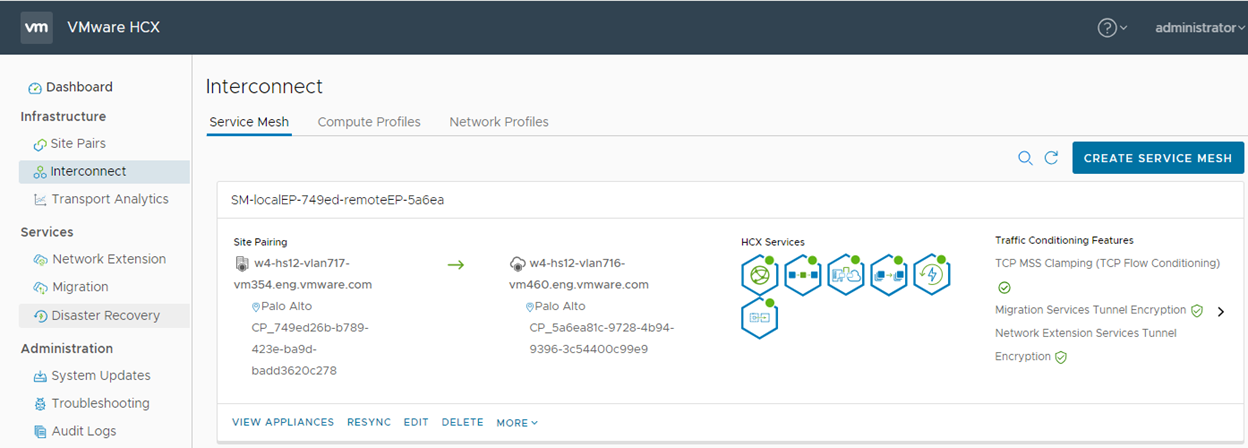When HCX Migration, Network Extension, WAN Optimization, and Disaster Recovery services are activated, HCX deploys the associated virtual appliances in the source site and corresponding "peer" virtual appliances on the destination site. The Service Mesh activates the configuration, deployment, and serviceability of these Interconnect virtual appliance pairs.
Service Mesh Benefits
- Uniformity: the same configuration patterns at the source and remote sites.
- Reusability: Once a compute profile is created, it can be used to connect to multiple HCX sites.
- Multi-site ready: Compute Profiles and Network Profiles can be shared across multiple sites.
- Ease of reconfiguration: New capability to pool datastores or modify them after deploying an Interconnect network structure.
- Scale-out deployment: The HCX-IX appliance can be deployed per cluster or a single HCX-IX can be shared across multiple clusters.
- Parallel execution ensures faster Interconnect deployments (in under 5 minutes).
- Lockless model ensures parallel configuration of network stretches.
Note: When extending or unextending multiple networks that are part of the same Network Extension High Availability (HA) group, only one network extension operation runs at a time. Other network extension requests are queued until the current operation finishes.
- Interfaces display a clear deployment diagram.
- Task-tracking features provide incremental details for each step of the progress of operations.
- Preview of required firewall rules to avoid configuration difficulties.
Service Mesh Components
The Service Mesh logic determines the transport fabric and defines what services are associated with a site pair based on a number of component factors:
- License entitlement
- Establishes the service entitlements provided by the license entered during HCX activation. See About HCX Licensing.
- Network Profile
- Defines what networks are used for connecting virtual appliances and for HCX management and dataplane operations.
- Compute Profile
-
Provisions the infrastructure at the source and the destination site. Defines the placement details (Resource Pool, Datastore) where the system places the virtual appliances.
Note: The integrated Compute Profile creation wizard can be used to create the network profiles (or Network Profiles can be pre-created).
The Service Mesh, Compute Profile, and Network Profile information is accessible by navigating to from the HCX Console.

To show additional Service Mesh selections, select More or click the right navigation arrow to expand the display.

The expanded display provides the following selection tabs:
- Topology
- Displays a graphical representation of the Service Mesh connections and services. Click on an entry in the display for additional details.
- Appliances
- Lists details about the source and destination appliances deployed for each Service Mesh. For information regarding the management options available after selecting this tab, see Manage Service Mesh Appliances.
- Tasks
- Provides a detailed list of tasks associated with Service Mesh operations.
- Data-Plane Diagnostics
- Run data-plane diagnostics to troubleshoot issues in your Service Mesh. Refer to Understanding Data-plane Diagnostics.
- HA Management
- Displays information and appliances related to Network Extension High Availability groups. See Understanding Network Extension High Availability.
- Sentinel Management
- Provides options for downloading and managing the Sentinel Agent software, which must be installed on guest workloads migrated using OS Assisted Migration. This tab appears when the OS Assisted Migration service is selected in the Service Mesh configuration. See Sentinel Management.
Creating a Service Mesh
The process for creating a Service Mesh varies depending on whether the site pairing is with vSphere-based sites or with non-vSphere sites.
For vSphere-based site pairs, the Service Mesh is always applied at the source site. Follow these general steps for creating a Service Mesh for paired vSphere-based sites:
- Pair HCX sites. See Creating and Managing Site Pairs.
- Create a Network Profile for the source and destination HCX sites. See Create a Network Profile.
- Create a Compute Profile for the source and destination HCX sites. See Create a Compute Profile.
- Create the Service Mesh for the Site Pair. See Create a Service Mesh for vSphere-based Site Pairs.
HCX Interconnect service appliances are not deployed until a service mesh is created.
- Pair the non-vSphere site. See Creating and Managing Site Pairs.
- Create a Network Profile for the vSphere-based HCX site. See Create a Network Profile.
- Create a Compute Profile for the vSphere-based HCX site. See Create a Compute Profile.
- Create the Service Mesh for the Site Pair. See Create a Service Mesh for Non-vSphere Site Pairs.